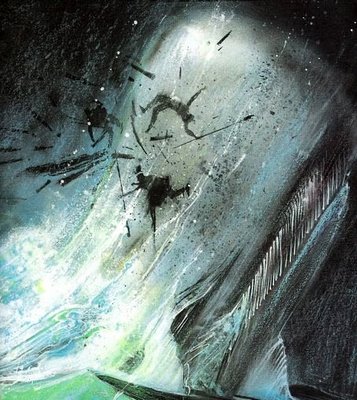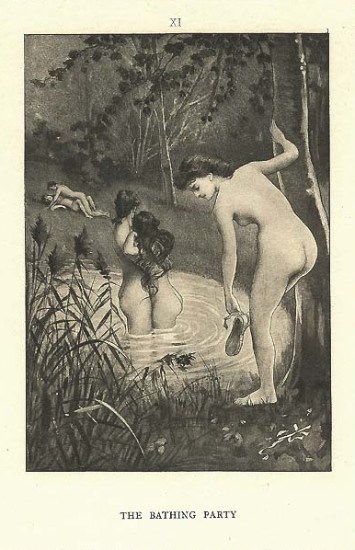This first appeared on Comixology.
_________________
Narrative entertainment for guys tends to come in two broad categories.
First, you’ve got the type of story epitomized by Moby Dick. Manly men doing manly things, almost entirely with each other. Guys lolling about under the covers together and comparing tattoos, or holding hands under the open sky as they wade through whale blubber. These are sweaty, hairy, deep-throated narratives; narratives red in tooth and claw; narratives of man vs. man, man vs. nature, and man vs. his own body odor; narratives where, in short, every chromosome that matters ends in Y.
Second, you’ve got stories like Fanny Hill. In these tales, male characters are present, but secondary. What really matters is some vivacious, voluptuous, double X, into whose mysterious consciousness and orifices the reader and writer together raptly penetrate. Bloody conflict is replaced by fluid congress, silk sheets, perfume, lidded glances, and flesh in various degrees of drapery. The thrill is in knowing women from the inside out; in replacing, possessing, and becoming the object of desire.
I am excessively pleased with these categories, mostly because it allows me to label a wide array of cultural products as either Dick or Fanny. (The Old Man and the Sea — Dick! Breaking the Waves — Fanny! Go on, try it…it’s fun for the whole family!)
Where was I, anyway? Oh, right. In addition to the obvious adolescent satisfactions (Escape from New York — Dick!), I think the hermeneutic is also useful because it allows one to sidestep some of the more tired cultural arguments. For instance, the Dick/Fanny breakdown has little to do with quality or caché. Dick is epitomized equally by Herman Melville and James Bond (the latter of whom sleeps with women only as a strategy to get him closer to the villain, his real object of interest). Fanny, too, has high-brow permutations like Pedro Almodóvar or D.H. Lawrence, and lowbrow ones like Russ Meyer or Bella Loves Jenna.
By the same token, Dick/Fanny does not equate to sexist/feminist. Since Dick and Fanny are categories of male fiction, they both do tend to be sexist for the most part…though there are some exceptions (I think Jack Hill’s Pit Stop is an example of non-sexist Dick; his Swinging Cheerleaders is an example of non-sexist Fanny; you can see a fuller explanation here.) In any case, the point here is that Dick and Fanny don’t have a particular qualitative or moral value attached; one isn’t necessarily better or worse than the other.
Now that we’ve got that all, er, straight, let’s pick up our Dick and shift over our Fanny, and take a look at comics, since that’s supposed to be what we’re all here for.
American comics are, by and large, written primarily by men, for men. This is true of the mainstream super-hero books; it’s true of the classic underground titles, and it’s true to a somewhat lesser extent of the present-day alternative comics scene as well. (I’m going to ignore newspaper comic strips, which, at the moment, don’t really seem to be written for — or indeed, by — anyone.) So, since they mostly fit in our broad category of male narratives, which American comics can we classify as Fanny and which can we classify as Dick?
There are definitely some Fanny comics out there. Pretty much the entirety of porn qualifies, from Lost Girls to Housewives at Play. A fair bit of Crumb’s stuff is Fanny, as I’m sure he’d be pleased to hear. The Los Bros Hernandez books and Dan Clowes’ Ghost World are also obsessed with female bodies and/or psychology in a way that strongly suggests Fanny. There’s Catwoman, I guess. And then there’s….uh…maybe Chris Ware’s Building Stories? And also, um….
Not a heck of a lot, really. American comics are, as it turns out, not only overwhelmingly male-oriented, but also veritably awash in Dick. All those mainstream super-hero titles with muscle-bound good guy/bad guy pairs obsessing about each other; all those angst-ridden autobio drones whining about their isolated alienation from women, ….it’s all Dick, Dick, Dick all the time. Sure, there’s the occasional willing alterna-chic or preposterously attired superheroine to lend some T&A…but why are they so rarely the fetishized focus of the action? Kick-ass female-lead eye-candy has been a schlock staple in television and movies for the last decade. What’s comics’ problem?
Again, this isn’t necessarily to say that more Fanny would make comics objectively better. There are lots of good Dick cultural products, and bad Fanny can be quite, quite bad. But it does make you wonder. Lots of folks have pointed out that American comics don’t really reach out to women or girls or children — and they don’t, and they’re probably not going to, ever. But even if you accept that the core audience for American comics was, is, and most likely always will be increasingly paunchy guys, it still seems like the offerings are fairly limited.
Minx was doomed from the start, but surely, surely, if your main audience is men, you could produce an R-rated line devoted explicitly to sexploitation-style sleaze and get some of your regulars to buy it? You could even bring back some of the classic genres of 70s cinema; nurse comics, cheerleader comics, women-in-prison comics, rape-revenge comics. Call me a dreamer, but I know in my heart that my fellow comic readers would like Fanny just as much as Dick if they were only given the chance to try it.
__________
Illustration credits: Bill Sienkiewicz’s illustration from the Classics Illustrated Moby Dick; Paul Avril, Illustration for a 1908 edition of Fanny Hill



Hmmm, well, it’s an interesting argument you have here, but here’s my counter argument. (I’m not familiar with “hermeneutic” theory so I could be missing the point of your article entirely)
You’ve probably read “Pierre Menard, Author of the Quixote” by Borges? As the author in that story interprets Quixote in the context of events that happened since 1602, you’ve interpreted “fiction for men” in the context of shelf placement.
Stick a male author’s name on the cover jacket to The Hunger Games (well, honestly I’ve only seen the movie) and it’s all about “replacing, possessing, and becoming Katniss”. Place a woman’s name on the cover or place it in the woman’s section and it’s a different cultural product altogether.
To paraphrase Borges “The depiction of female characters of Menard—quite foreign, after all—suffers from a certain affectation. Not so that Meyer, who handles with ease the depictions of a young woman’s internal life. “
No, I don’t think that’s right. The Hunger Games just isn’t exploitive at all the way fanny fiction is. The love triangle is all wrong too; fanny is about girls having lots of different men and (often) lesbian subtext; the girl-has-to-choose-between-two-hunky-guys thing is totally a romance for girls trope.
Male and female genre fiction designations are in some sense arbitrary marketing categories — but the marketing categories themselves affect content and have a major effect on genres over time. You don’t turn fanny into romance just by reshelving it.
“the girl-has-to-choose-between-two-hunky-guys thing is totally a romance for girls trope.”
Marvel comics has had one girl two guy pairings with Sue Reed/Namor and Jean Cyclops/Wolverine.
But I do see your point. You’re saying Catwoman is Fanny due to the cheesecake, not due to the female protagonist? (Meridian, the Crossgen comic about a teenage girl princess, was aimed at girls but mostly read by direct market male readers if I remember a podcast interview with the Barbara Kesel correctly. )
Right; Catwoman definitely sounds like fanny. It’s the fetishization of the female protagonist, not just having one.
Marvel comics of that era were definitely partly influenced by romance tropes. The triangles tended to be strongly from the perspective of the guys in most cases though, rather than form the viewpoint of the women.
Not sure I grasp the concepts fully — from the title I expected something about the electronic musician Moby and Lauryn Hill (yes, seriously). But Claremont’s X-Men would seem to count as “fanny”, at least the issues after Dave Cockrum’s second go-round. Claremont is positively obsessed with women and their often — verrrrrrrrrrry barely — sublimated romantic/sexual relationships with one another; the guys mostly seem like a distant afterthought. IIRC, though, few of the artists played along, other than maybe Alan Davis; if only Claremont had been able to work with Manara a few decades earlier.
Naturally the break-out character turned out to be Wolverine, one of the manliest man’s man of all time.
I think the Claremont X-men are pretty interesting in this regard. Definitely elements of Fanny…but also some effort to actually appeal to female readers with Kitty Pryde, who had a lot of space devoted to her and was clearly meant as a point of identification for teenage girls. But then too as you say there’s Wolverine, who is very much Moby…
I think Red Hood was supposed to sort of be trying for sexploitation sleaze, but it ends up still obsessed with the boring frat boy protagonists first and foremost.
Speaking of one girl-two boy triangles… Decades before Twilight there was a fantasy novel called War For the Oaks by Emma Bull, starring Mary Sue and the two hunky elven boys who desire her. It remains a touchstone for a fair number of readers who discovered it at a receptive age. I don’t really have an on-point point, but I suspect it’s an HU subject waiting to happen.
That’s the book that started the urban fantasy genre, isn’t it? Or am I confusing it with something else?
I dunno the history of urban fantasy as a genre/marketing category, but it is my understanding that War For the Oaks certainly popularized, if not started, the whole thing. I couldn’t finish it (I thought it would have been better if the two hot boys ignored her and the forth team member, an ugly dwarf, fell for her instead) but for people who want Mary Sue fantasy, it’s probably an ideal book, with enough with and craft to make it a swell ride.
Here’s a fake trailer Emma Bull’s husband directed:
http://www.myspace.com/video/sarah-alyse/war-for-the-oaks-trailer/312815
Enjoy!
The wiki summary of War For the Oaks makes it sound like a 70s concept album:
“[…] Eddi soon finds herself in a struggle for survival against the Unseelie Court, all while trying to put a new rock band together. […] The novel climaxes in a rock concert playoff between Eddi and the Queen of Air and Darkness, which decides the fate of both faerie courts, as well as the fate of her loved one”
Speaking of Kitty Pride, what’s the deal with her and Colossus? Haven’t read those comics, but I read a post by Abhay Khosla where he said in Secret Wars “There was a lot of fighting and Colossus cheated on his pre-teen girlfriend. ”
I did read some of Whedon’s X-men, and Kitty Pryde is all like “Oh, Colossus, I’m above the age of consent and you’re back from the dead, we can finally have sex!”
Kitty wasn’t featured in any of the cartoons, and that was my first exposure to the character, so I was like “Oh this Kitty girl is the 80s version of Jubilee!”
IIRC, Kitty was not pre-teen when she first appeared, more like 14 or 15. Colossus was a big guy, but he was supposed to be around 18 or 19. So the age difference really wasn’t that huge, though it would have still been statutory rape had they slept together. And they never actually had sex in the Claremont run.